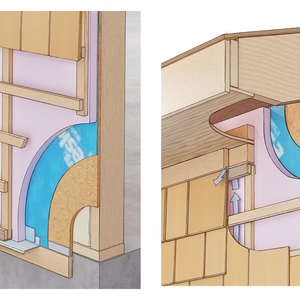Roofing over “Insulspan” roof panels
Next spring I’ll be enlarging my cottage by adding a second floor (using attic trusses). I’m interested in sheathing the roof with the foam filled panels (i.e.: Insulspan Panels).
My question is what’s the best way to “roof” (shingles or metal roofing) and how do you ventilate the roof? The building is located in northern Midwest.
I’ve read the top layer of OSB can rot due to lack of ventilation and since this will be a retirement home, an ounce of prevention is worth a pound of cure.
Any suggestions are welcome.



















Replies
Well Bill,
I have reaserched it rather completely, I'm right now building my timberframe home with SIPs (structural insulated panels) (foam panels) what I found out is the devil is in the details.
Make the roof itself tight, and then if you choose to use cedar shakes/shingles use cedar breather under them so they don't rot..
cedar breather is a product designed to hold the shake/shingle a little off the deck..
I choose to use Ice and water shield over the whole roof rather than just at the edges as is most common.. the reason is that it cost relatively little when compared to the costof 30 pound felt (tar paper) and the added benefits it had made it a worthwhile decision for me..
some shingle makers will allow you to install their product directly over the roof of a SIP while others won't. the brand selected will determine which..
I've seen some rather bizarre or extreme methods used by those who fail to understand the differance between a sip roof and a regular roof.. one of the more foolish is to fir out the roof and then put another deck over it. sort of a belt and suspenders approach that really achieves nothing. as for the selection of Metal standing seam roofing, that's a cosmetic question. You judge if you like it, I don't but please don't let me interfer with your choice..
By the way, I'm in Minnesota..
Help needed...any advice?
Check the report from SIPA.. (Structural Insulated Panel Association) "Report on the Juneau, Roof Issue"
We built our house 17 years ago and used the insulated panels to build our entire house. 17 years later we had damage to our roof (just like what happened in Alaska). We contacted Insulspan (pictures and all--even sent them a sample off the damaged panel) no response. $40,000.00 later (out of our own pocket) we had a second roof built over the damaged roof) The interior ceiling in our house has cracks galore...still not repaired. Any suggestions on how to get help! We tried our insurance company and they said it was due to the panels. HELP! P.S. Living in Northern Minnesota, too!
Bill,
The issue of a panel skin rotting obviously is a result of moisture. The first way to allow moisture to harm your panels is to put a leaky roof over your panels. If that base is covered, the next avenue for unwanted moisture is via warm moist air escaping from your insulated envelope. This moisture laden air is just looking for a cold exterior to condense upon. Therefore, proper installation of your panels and especially the sealing of your panel joints is critical.
Insulspan has recently added assurances of quality installation by introducing a joint sealing tape that is applied to all roof panel joints. This tape is a belt and suspenders approach to ensuring an air-tight joint. Remember, build it tight and ventilate right! When I say ventilate, I don't mean your roof. Controlled ventillation in a SIP structure is vital for maintaining proper humidity and indoor air quality.
As for the type of roofing, take your pick & pick your budget. If shingles are your choice, I recommend and provide Elk shingles to all my SIP customers. If you elect to go with metal, consult with the manufacturer of the metal and verify that there fastening pattern is sufficient for 7/16" OSB. We find that an increased pattern is sometimes specified to maintain pull-out / uplift values.
Good luck, Good Choice, Good Day,
Al
You might what to look into a installing a second false deck over the sips I have seen problems from heat leakage at the seams in the sips panels.I would also have a concern about the roof temp in the summer when the heat load is reversed, this would also help with the moisture concerns
Doc,
If a panel joint is leaking, fix the joint. Don't cover it up with a false deck (cold roof)and hide the symptoms of potential failure. A leaking joint gives off plenty of signs. I've seen and repaired panel joints that give clues that heat &/or moisture are escaping. However, a cold roof doesn't stop the joint below from leaking, it dosen't stop condensate from condensing, and it certaintly dosen't give you the tell tale clues of potential problems.
I would never recommend a second deck over a panel roof.
One mans opinion,
Al
How does one fix a leaking joint in a sip panel after installation?As for causing condistation if the roof deck/system is proprely ventilated(venting top and bottom as all shingle manufactors ask for)a air flow or convection is created,Have you ever tried to remove shingles or ice and water shield that has applied directly to a plywood surface under normal conditions?it kinda melts to the roof deck
As for metal panels they two have air flow be it small but it is there.Have you been in or worked on a large prengineered building where the roof is the roof and the insulaltion is rool out over the purlins and sags down 1' to 18"? I have worked on many some of them in the 124000 sq. range never seen a condisation problem,but in almost every one I did a fastner or penatration leak problem
How does one fix a leaking joint in a sip panel after installation?
Remove the shingles and felt, drill access holes (1/2"), inject a TWO part expanding foam into the voids along the joint. This will create the continuous foam envelope that should have been created during original panel installation.
As for causing condistation if the roof deck/system is proprely ventilated(venting top and bottom as all shingle manufactors ask for)a air flow or convection is created,
I'll assume we're referring to ventilating above a SIP and under the shingles on that SIP. Not all shingle manufacturers insist on venting. Some actually look at the test data and admit that unvented shingles has little or nothing to do with shingle longevity and therefore warranty. In addition, if venting is installed, the "cooler"air that passes thru the vents ensures that the top skin maintains a lower temperature then if it were not vented. The presence of warm moist air leaking thru the joint isn't going to be wisked away with the convection currents that may be present in a vented system. It's going to condense.
Have you ever tried to remove shingles or ice and water shield that has applied directly to a plywood surface under normal conditions?it kinda melts to the roof deck
Yes I have, and your right it can be sticky and seemingly melted to the roof. However, I've also seen properly installed shingles on top of improperly installed SIPs. The escaping warm air will cause the shingles to soften and expand along the flawed joint. The "tell-tale" sign of a problem is the ridging formed by expansion along the joint. Remember the vented roof system? You will not get shingle ridging because of disipation of heat within the vent channels. Therefore, you have a problem that will continue to grow undetected because of venting.
As for Ag biuldings or metal structures with rolled fiberglass insulation. Your extremely lucky never to have seen one "sweat" in cold weather. Find one with a tear in the insulation, and you'll see her sweat during the cold months.
Regards, Al
Panelwright,
Thanks for the your comments. If given a choice would you go with SIP or traditional framing?
Sounds like SIP could be a problem if not done "exactly" right and I'm wondering if traditional construction isn't a safer way.
Thanks for your comments.
B
Bill,
You said in the beginning of this thread that you would be using trusses, and wanted to use panels as the sheathing.
If you are merely using the panels as sheathing & insulation but leaving the structural work to conventional trusses, I'd say it's a toss up. If you combine your roof detail (panels over trusses) with 8-9' flat ceilings and installation by yourself, I 'd recommend going conventional. With a raised heel truss and a thick layer of blown-in insulation your efficiency will be comparable and your costs much less.
However, if your addition design incorporates a vaulted ceiling and you can use the SIPs in the manner their most effective (Structurally), I say trash the trusses and fly the panels.
The installation of panels is not difficult. A few simple rules and your job is as sound as 98% of all panel jobs. It's the 2% that have blackened the eye of our industry, and the vast majority of those were a result of poor installation.
If you opt for the panels and are concerned about the details, contact me directly and I'll gladly help you.
Good luck with your project regardless of your path,
Al
The biggest reason for rot with these panels is from moisture withing the building envelope. A mechanical heat recovery/ventilation/humidity control suystem is needed with a house built this way.
The other important thing is that ALL jouints in the material be sealed with spray foam as it is installed to keep interior maoisture from migrating to the osb surface.
Then there is the issue of some asphalt shingle manufacturers voiding warrantees when there is no ventilation behind them - otheres don't and I don't see it as a valid disclaimer - colour of shingle makes more of a diff in longevity.
You can roof with any kind of material you want if it is done correctly.
Excellence is its own reward!
After reading your post again, I see another potential issue.
You used the word "cottage"
Sometimes that word or "camp" or "cabin" can denote some substandard construction. Not trying to imply you have a dump because we have some "cottages" that look more like mansions so I'm not sure where you are starting from.
Have you affirmed that the foundation and first floor framing is sufficient to handle the weight of another story on the structure? Is there a vapor barrier to prevent ground moisture from entering the house from below? That water will end up at roof level eventually without a ventilation system. Maybe you could tell us more about the whole house. Are you designing yourself and doing the work too?.
Excellence is its own reward!
Edited 11/2/2003 8:17:42 PM ET by piffin
If for any reason you decide to use asphalt shingles, either three tab or architectural, bear in mind that many shingle manufacturers will not honor their warranty if applied over SIPS. You would need to contact the manufacturer and ask if their warranty applies over the brand of SIPs you'll use.
Formerly BEMW at The High Desert Group LLC